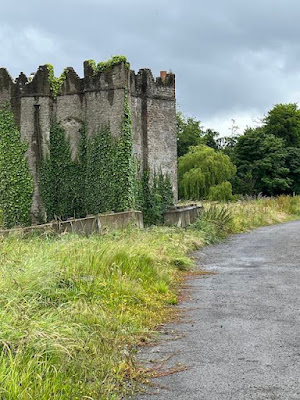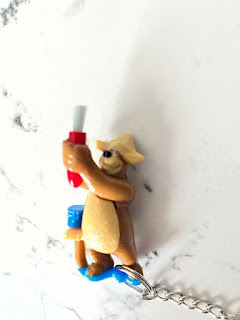We woke up Sunday morning at 5:15 to discover a message from American Airlines that our flight had been cancelled and we were scheduled to depart on Tuesday instead on a connection with 3 legs instead of 2. I tried to see if there were connection options to choose from, but there were not. Guess we get what we get and don't throw a fit. We focused instead on what we were going to do with ourselves for two more days in Dublin (after we confirmed that we could stay in our current hotel for 2 more nights).
David and I decided to geocache near the hotel. Its out near the airport and there were some promising caches that said they held travel bugs. I hoped to swap my current buddy out for another to take home.
The first cache was in a newly developed neighborhood with a walking trail through a very old estate. The building is a tribute to George Washington that the estate owner built in 1778. He was apparently a big admirer of Washington. Its one of the few monuments built while Washington was still alive.
We found the cache a picked up a new travel friend, but unfortunately it was not wide enough to hold my current travel bug, so I now have two travel companions.
We tried for one more cache up the street at this old church - St Dolough's. The oldest part of the building dates to 1140 AD. A hermit monk lived on the premises, locked in a cell and dependent on others to sustain him. There was a pretty run down cemetery. The few stones we could read were dated to the 1800s. No luck with the 2nd cache though, it was somewhere deep in the brambles that we didn't want to fight with.
We purchased tickets for Riverdance and headed back into the center city for the show. David and I decided to try for a nano-sized cache on a very busy street (above). We normally try to avoid these because we are pretty obvious when we are looking. We stood across the street from the site and scoped things out, then David wandered over to look. He didn't see anything obvious, but a man was blocking one possible site. When he moved, I wandered that direction and found it right away. One person on the app log suggested "using the selfie method to retrieve it" so that's what we did. Posed in front of it and I wrapped by arm over David's shoulders to pick it up.
We walked away from the site to sign it and then did the same thing in reverse to get it hidden again. Success!
The Gaiety Theatre Dublin
Riverdance was wonderful! Extra fun that we saw it in Dublin!
After the show we indulged in some yummy Italian desserts!
For our last day we decided on a few more museums. We started at the EPIC museum of Irish Emigration. It was a great museum! Everyone got a 'passport' as they entered and they stamped each room you visited (total of 20). The exhibits started with reasons for why various waves of Irish emigrants left the island. It told individual stories and put things in good context. It talked about their impact in their new communities and then looked at the export of Irish culture with these emigrants. It was very interactive and the kids who were there loved the various exhibits. There were lots of touch screens and some 'smart' projections that responded to when you stood on various parts of the projections (factoid quizzes, etc).
This screen was particularly cool. Each ribbon scrolled independently on its thread and when you touched the ribbon, it would widen and pause scrolling to show you more details, then shrink and start scrolling again. I've never seen anything quite like it. It took up 6 screens.
There was a whole section on Gaelic sports including hurling (which we watched in the bar the previous night). Apparently they played hurling matches in Argentina until WWI when the hurley balls were no longer exported.
This is the stick/paddle they use to play. I don't think I can even come up with the combo of sports that hurling is like. There are goals at each end shaped like H's. Above the bar is 1 point, below the bar is 3 points. You hit the hurley with the stick and can also throw it, but you can't hold on to it for more than 4 seconds (?) It was mesmerizing to watch. Very fast paced. All the hurley smacking in close proximity made me goggle that the only safety gear they had was a helmet and face shield.
There were notes about all the famous people with Irish heritage, including JFK among many others. I can see the real sense of pride in this web of cultural connection.
This room has a video of Riverdance playing and foot markers on the floor to try to mimic their dance steps. It was fun to watch other guests try to follow them.
There was a room dedicated to poetry and literature. You could pull some 'books' out and an audio recording would play quotes from the books.
We had lunch in the old Customs House on the Quay and then headed to the National Museum of Ireland - Archeology. It was a good museum with lots of artifacts in great condition and well labeled with clear contextual background. I took a few photos, but tried to rein it in.
Its a beautiful building.
With beautiful mosaic floors.
Many of the items on display had been preserved in the bogs and eventually unearthed by peat harvesters.
This was a wicker fish trap dating back to 5000 BC!
These are jade axeheads dating to 4000 BC. The jade originates from high in the Northern Italian alps. Since they show no wear and were made from stone from so far away, they were likely ceremonial pieces.
I had never seen a stone mold for making metal dirks. This dates to 1400 BC
I was astounded by these horsehair tassels. They date to approx 700 BC!
The preserved remains of various 'bog men' were the most intriguing. This one dating to 300 BC was damaged below the waist by the peat harvesting machinery, but some of the organs remained and a clearly visible face with unusual hair. Analysis indicated that within the 4 months before his death, his diet had been predominantly plant based, meaning he likely died in the summer/fall before the heavy meat-based winter diet. Its astounding what they can discover with various techniques these days.
This was dates to approx 200 BC. His hands were well preserved and did not show signs of manual labor so he was of high social status. He was decapitated and his nipples were cut off. The display explains that this was signficant because a ritual of submission to a ruler involved sucking on the king's nipple, so this man would never be able to be a ruler in this condition.
I was particularly surprised to see the fabric that has been preserved in the bogs. The brown skirt was found in a bog in 1843 (not sure when it dates to).
One exhibit talked about what we know and don't know from archeology. There is reference to a particular battle dating back to the 1000's with a hero king who beat back the foreign vikings, but there no archeological evidence of the battle as the legend has it. It is likely that much of the lore was embellished in the 1800s as Irish nationalism increased with British rule.
So long Ireland! It's been fun.


























No comments:
Post a Comment